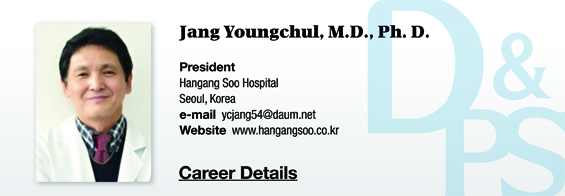The process of wound healing is a combination of a series of complex steps such as cell proliferation, migration, matrix synthesis, and contracture that lead to wound repair and healing. It can be divided into 3 phases as below, or into more subdivisions:
① Inflammatory phase; emergence of neutrophil and macrophage
② Proliferating phase (fibroplasia); cell differentiation and migration (keratinocyte, fibroblast, endothelial cell, etc.)
③ Remodeling phase (maturation phase).
[Advertisement] Tulip(Skin Tightening & Lifting) – Manufacturer: DANIL SMC(www.danilsmc.com)
Wound healing is the process of tissue repair as part of tissue response to injury. This series of biologic events entail hemostasis and inflammatory responses, followed by the formation of connective tissues, wound covering by epithelium, and then wound remodeling. These processes may overlap with each other or occur simultaneously. Wound healing can be divided into 1) inflammation phase, 2) fibroplasia phase and 3) maturation phase, each of which is controlled and regulated by biologically active substances called growth factors. A local wound healing process can be commonly observed in the skin, and the process can be summarized as follows:
- Clotting (hemostasis).
- Inflammation
- Granulation tissue formation; proliferation of fibroblasts and endothelial cells
- Epithelialization from wound margin(epithelial tongue).
- Collagen synthesis – Collagen remodeling –Scarring.
1. Hemostasis; Fibrin Clotting
Once tissue damage occurs, vasoconstriction ensues as a hemostatic response to control hemorrhage, and platelets are exposed to the collagen in the blood vessel wall below the endothelium. Platelet-derived thromboxane A2 and serotonin facilitate vasoconstriction (microvasculature constriction) and maintain acting factors within the wound. In the meantime, vasodilation occurs to deliver other healing factors to the wound. Vasodilation is controlled by histamine found in platelets, mast cells and basophils. Vascular permeability is also increased so that the healing factors could reach the wound.
The activated platelet aggregation process triggers a clotting cascade, and the intrinsic system is activated when Hageman factor, also known as factor VII, makes contact with collagen. Under the presence of high molecular weight kininogen, a precursor of bradykinin and prekallikrein, factor VII activates factor XI, factor IX, and then factor IX. In the mean time, extrinsic system is activated by thromboplastin, formed by phospholipid and glycoprotein released when circulating blood makes contact with the injured tissue. After passing through the final common pathway, both systems induce fibrin and fibrin polymerization and prepares scaffolding for cell migration, which is as essential for wound healing as hemostasis (in short, they cover the exposed tissue of the wound and prepare scaffolding for cell migration). The main components include platelet, thrombin, fibrin, fibrinogen, fibronectin, vitronectin and thrombospondin.
Growth factors and cytokines, contained in platelet alpha granule, work as chemotaxis signal to various cells involved in inflammation and stimulates epithelialization, collagensynthesis, angiogenesis and contracture.
2. Inflammation; Inflammatory Cell Proliferation
Although neutrophils control bacterial phagocytosis in wounds, it does not seem very important for wound healing considering that studies still report of wound healing occurring in animals deprived of neutrophils. They do however, increase the risk of infection. Some factors trigger inflammatory response by working as chemoattractants for neutrophils. Activated neutrophils release lysosomal enzymes, including neutral protease, elastase and collagenase, which aid free oxygen radicals and host defense. When these neutrophils are no longer needed, they are eliminated by tissue macrophages that migrate to the wound three days after sustaining the injury, where they play important roles such as regulating and controlling the wound healing.
Macrophages, through enzyme secretion and phagocytosis, control the degradation of extracellular connective tissues and regulate wound matrix remodeling. Such control over wound healing by macrophages is carried out by production of growth factors, including FGF, PDGF, TGF, interleukin (IL) and tumor necrosis factor (TNF) (they induce phagocytosis of increased pathogens, other cells or substrate fragments and stimulate the would healing process of surrounding cells by releasing cytokines and growth factors).
Neuroinflammatory reaction: Substance-P and calcitonin gene-related peptide (CGRP), sensory nerve-derived neuropeptides, are also expressed on fibroblasts and epithelial cells immediately after sustaining tissue injury. Many recent studies are investigating their role in wound healing as they are known to increase capillary permeability, stimulate vasodilatation, and induce cytokines or adhesion molecules for keratinocyte, endothelial cell and neutrophil chemotaxis and fibroblast proliferation.
3. Fibrogenesis; Fibroplasias
Fibroplasia, the second process of wound healing, starts when macrophages and fibroblasts are increased and neutrophils are decreased simultaneously. In other words, matrix formation, including collagen synthesis and angiogenesis occur . At this point, inflammatory response is ended, inflammatory mediators are no longer produced, and the existing inactivated inflammatory mediators are diffused from the wound or eliminated by macrophages. The neutrophil count in the wound is reduced, and fibroplasia continues for about two weeks, from five days after sustaining the injury.
Fibroblasts migrate to the wound and response to the mediators released during the inflammation period is repeated. These mediators include C5a, fibronectin, PDGF, FGF and TGF.
When extracellular matrix is injured, platelets and fibrin adhere for hemostasis and capillary permeability increases for extravasation of plasma, making it the main component of extracellular matrix. They are mostly composed of thrombin, fibronectin, fibrin, laminin, vitronectin, etc., which prepare and stimulate cell migration, proliferation and angiogenesis.
Extracellular matrix is made up of proteins embedded in polysaccharide gel, released by fibroblasts. These proteins include structural proteins, such as collagen or elastin, and cell-adhesion proteins, such as fibronectin and laminin (which are the main components of the baseline membrane of blood vessel epithelial cell lining). The polysaccharide gel is comprised of glycosaminoglycan and proteoglycan, which let nutrients into cell and maintain cellular structure. Adhesion proteins attach cells to matrix.
Although fibronectin is an adhesion molecule just as thrombospondin, von Willebrand factor or laminin, it also works as a strong chemoattractant for monocytes to differentiate into active macrophages. It also has opsonin (a substance that helps phagocytosis of leukocyte) activity.
Extracellular matrix is composed of hyaluronate and fibronectin, which make chemotactic factors, formed during fibroplasia healing phase, help cellular migration. Hyaluronate produces chemical gradients that has affinity for fibroblast. Fibronectin can bind to protein and fibroblast in the matrix and prepares a pathway for fibroblast. Fibroblast combines with arginine-glycine-aspartic acid sequence over fibronectin, and the fibronectin receptor in the fibroblast changes through cell membrane and combines with actin filament, which allow cells to migrate along the fibronectin strand according to chemotactic gradients. Fibroblast also produces other matrix proteins, such as proteoglycans or structural protein. Proteoglycan is a protein that polysaccaride can attach to.
PDGF stimulates fibroblast replication and has a chemotactic capability. TGF-β helps fibroblast to synthesize fibronectin and collagen, and EGF also facilitates collagen production. As the most commonly detected protein in mammals, collagen is a type of protein rich in glycine and proline released by fibroblast. There are currently 12 types of collagen described so far. Collagen is in a sturdy α-helical structure, where the collagen strands are cross-linked, preventing their breakdown. Collagen, therefore, plays a very important role for mammalian structure in wound healing. Macrophages control the release of collagen from fibroblast by growth factors, such as PDGF, EGF, FGF and TGF-β.
Other than the above described extracellular matrix, molecules that appear temporarily in wound environment, such as SPARC, tenascin and thrombospondin, also play important roles between cells and matrix.
SPARC and thrombospondin are known to be essential for angiogenic response to tissue injury, and tenascin for epithelial-mesenchymal interaction for fetal morphogenesis and wound repair. Hyaluronic acid, heparin sulfate, chondroitin sulfate and keratin sulfate are known to be important for producing an adhesive link between cells and other matrix. Meanwhile, the property of chondroitin sulfate and collagen I copolymer producing complete dermis has led to the development of Integra, which has recently gained popularity as an artificial skin.
-To be contined-
▶ Previous Artlcle : #7. Overview of Wound Healing Ⅱ
▶ Next Artlcle : #8-2. Wound Healing Process





















